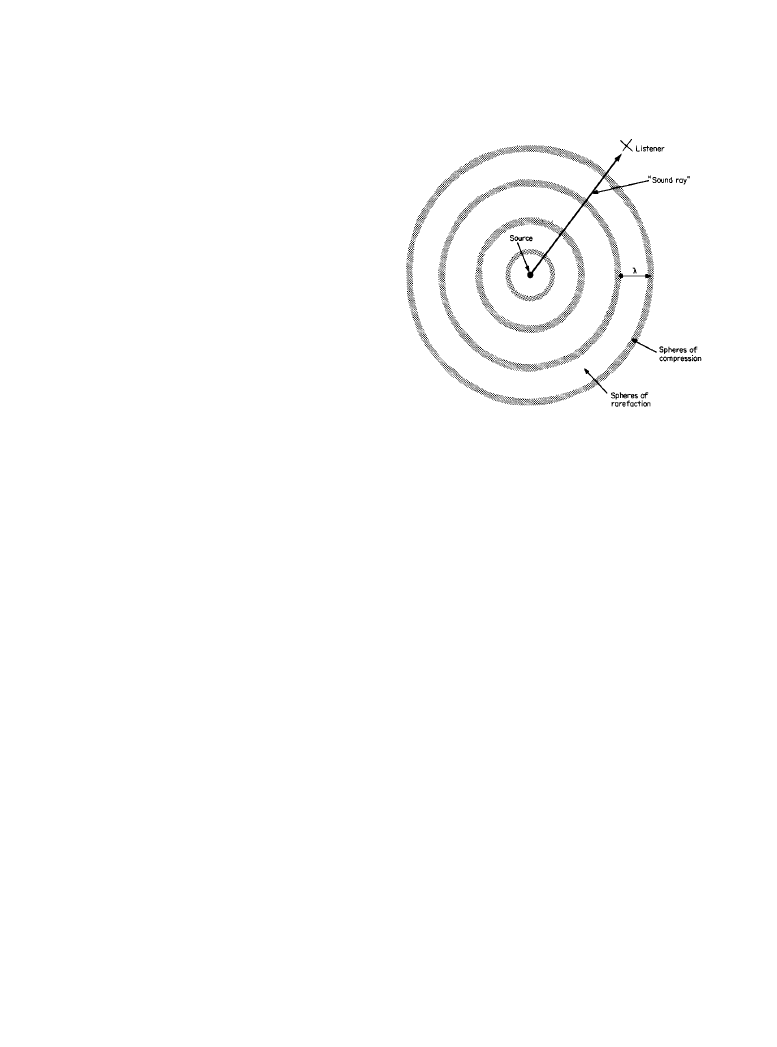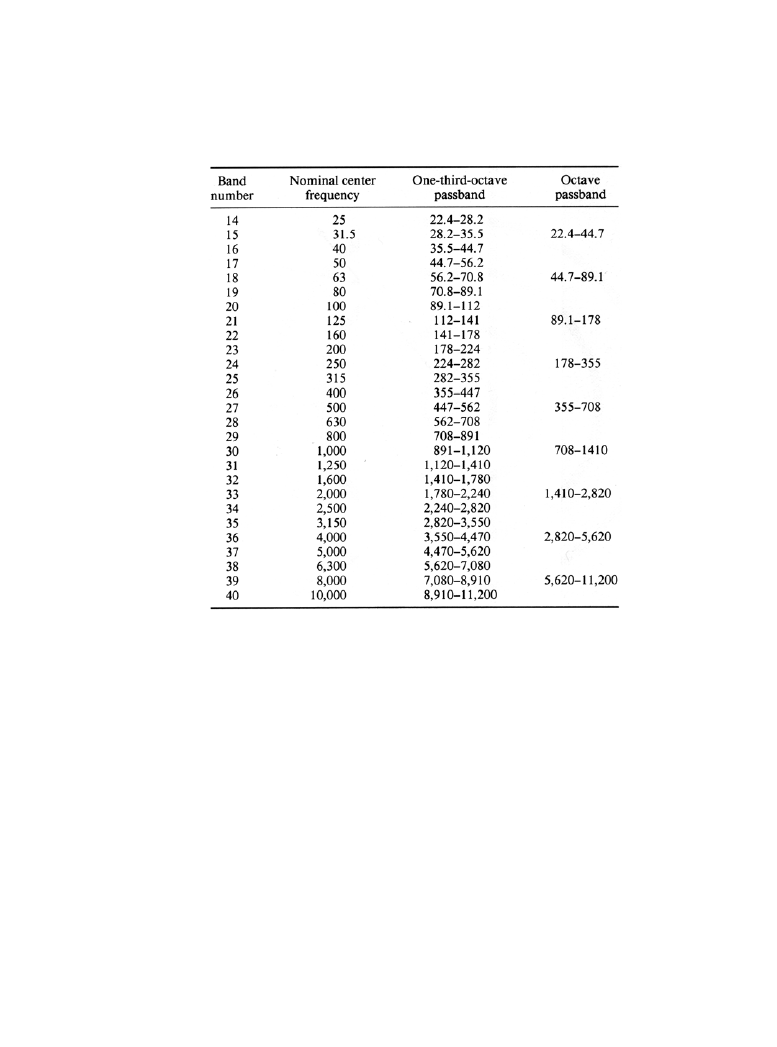ВУЗ: Казахская Национальная Академия Искусств им. Т. Жургенова
Категория: Книга
Дисциплина: Не указана
Добавлен: 03.02.2019
Просмотров: 21609
Скачиваний: 19

3-5
Chapter
3.1
The Physical Nature of Sound
Richard G. Cann, Anthony Hoover
3.1.1
Introduction
This chapter encompasses the following basic aspects of sound propagation: the propagation of
sound through air, the reflection of sound from a wall, and the transmission of sound through a
wall. Also considered are the absorption of sound by materials, the criteria for desirable and/or
undesirable sound, and methods for both improving the quality of desirable sound and reducing
the impact of undesirable sound.
3.1.1a
The Hearing Process
Although each listener is unique, there are bounds within which most listeners fall. Thus, over
the years, standards have been developed for both measurement instrumentation and measure-
ment procedures. The Acoustical Society of America publishes, on behalf of the American
National Standards Institute (ANSI), a catalog that summarizes each standard. There is also an
index that lists international standards [1]. In addition, there are many U.S. trade and professional
societies that publish standards that relate to noise and their specific activities.
The manner in which the ear perceives sound is exceedingly complex. In some ways the ear is
more sensitive to sound than acoustical instrumentation, being able to detect sound qualities that
are extremely difficult to quantify. However, the hearing process may also interpret tonal sounds
that in fact do not physically exist.
3.1.1b
Computer Design of Acoustic Systems
A variety of computer programs are available to assist the designer concerned with architectural
acoustics. Some programs are supplied either gratis or for a small fee by the manufacturers of
building components. In addition, some programs may be purchased for generic applications.
However, caution should be exercised when using these programs, for calculations performed by
the computer may not be documented thoroughly and may not suit a particular application or on-
the-job condition. Thus, it is possible to apply the programs improperly, resulting in substantial
error.
Downloaded from Digital Engineering Library @ McGraw-Hill (www.digitalengineeringlibrary.com)
Copyright © 2004 The McGraw-Hill Companies. All rights reserved.
Any use is subject to the Terms of Use as given at the website.
Source: Standard Handbook of Audio and Radio Engineering

3-6 Architectural Acoustic Principles and Design Techniques
3.1.2
Sound Characteristics
The simplest source of sound expands and contracts equally in all directions as if a perfectly
round balloon were rapidly inflated and deflated. The expansion and contraction of the source
results in three-dimensional sound ripples that spread out unimpeded in all directions as ever-
expanding spheres of compression and rarefaction at the velocity of sound. The rate at which the
point source expands and contracts is the frequency in cycles per second, usually expressed
numerically in hertz (Hz). The distance between consecutive spheres of either expansion or com-
pression is identified as the wavelength, as shown in Figure 3.1.1. These three parameters are
related by
(3.1.1)
where
c = velocity of sound, ft/s (m/s)
f = frequency, Hz
λ = wavelength, ft/Hz (m/Hz)
The speed of sound in air is approximately 1130 ft/s at normal room temperatures. For quick esti-
mates, this may be rounded off to 1000 ft/s. For design surveys, it may be more convenient to use
a simplification that sound travels about 1 ft/0.00l s.
Sound waves of all frequencies, whether from a low-frequency woofer or a high-frequency
tweeter, travel at the same speed. An international standard (International Organization for Stan-
dardization, Recommendation R226, 1961) sets middle A (so-called tuning A) at 440 Hz. From
Equation (3.1.1) this tone has a wavelength of 2.59 ft.
c
f
λ
=
Figure 3.1.1
Simple sound source.
Downloaded from Digital Engineering Library @ McGraw-Hill (www.digitalengineeringlibrary.com)
Copyright © 2004 The McGraw-Hill Companies. All rights reserved.
Any use is subject to the Terms of Use as given at the website.
The Physical Nature of Sound

The Physical Nature of Sound 3-7
3.1.2a
Sound Spectrum
The audible spectrum of sound ranges from 20 Hz to 20 kHz. The fundamental tone or pitch of
musical instruments ranges from piano at the lowest end of human hearing to about 4 kHz. How-
ever, every instrument also develops harmonics that are frequencies many times higher than the
fundamental pitch. These harmonics are important in our ability to identify types of musical
instruments.
For noise control applications, the frequency spectrum is conveniently divided into preferred
octave bands, the frequencies of which are shown in Table 3.1.1. Each octave band encompasses
the musical scale from F sharp to F. All noise control data are classified into these octave bands.
One-third-octave bands may be used for more detailed work.
Propagation
Expanding sound waves are sometimes depicted in acoustical diagrams by using sound rays such
as those shown in Figure 3.1.1. These rays are lines that are used to represent the radius of the
spherical wave and are arrowed in a direction away from the source. They must not be interpreted
as meaning “beams” of sound that travel only in the arrowed direction. Neither do they describe
in any way the amplitude of the wave at any point. Their utility is limited to showing primary
Table 3.1.1 Limits of Frequency Passbands
Downloaded from Digital Engineering Library @ McGraw-Hill (www.digitalengineeringlibrary.com)
Copyright © 2004 The McGraw-Hill Companies. All rights reserved.
Any use is subject to the Terms of Use as given at the website.
The Physical Nature of Sound

3-8 Architectural Acoustic Principles and Design Techniques
sound propagation paths in environments that are dimensionally larger than the wavelength of
the sound. This limitation is explained in more detail later in this section.
Sound waves travel away from a simple source in spheres of ever-increasing diameter. The
sound pressure is reduced in amplitude by a factor of 4 each time that the radius is doubled, since
the sound energy is distributed over the sphere’s surface, which has become 4 times larger. In
decibel terms, the new sound level is decreased by 20 log (ratio of distances).
Thus, when the radius or the distance that a sound wave travels has doubled, the sound level is
reduced by 20 log (2), or 6 dB. Conversely, each time that a listener’s distance from the source is
halved, the sound level increases by 6 dB. This is not true once a listener is close to the source.
Most speaker cabinets have dimensions of less than 1 m; this is typically the minimum dis-
tance at which the rule of 6 dB per distance doubling can be applied. At a distance of less than 1
m the sound level increases asymptotically to a maximum value at the vibrating surface.
Sound Power
Because sound pressure and sound power levels are usually expressed in decibels, a logarithmic
ratio, it is important to distinguish clearly between the two. Sound power level applies only to the
source, whereas sound pressure level is also dependent on the environment and the distance from
the source.
As an analogy, a common light bulb is rated in lumens to indicate how much light the bulb
produces regardless of the kind of room it is in. But the amount of light perceived by an observer
depends on such environmental factors as the distance from the bulb to the eye and the color of
the wallpaper. Sound power level cannot be measured directly but is calculated from measure-
ment of sound pressure level made with a sound-level meter.
Sound power is calculated from
(3.1.2a)
Where:
r = radius, ft
Q = directivity factor
(3.1.2b)
where r = radius, m.
3.1.2b
Directivity
Most sound sources are not omnidirectional like the one described in the previous section.
Instead, they emit sound more strongly in one direction than in another. The directivity character-
istic can be specified by means of a directivity factor. If an omnidirectional source is placed
against a large reflecting surface such as a floor, the sound will radiate only into a hemisphere, or
half of the previous solid angle. The directivity factor Q of this source increases from 1 to 2. If
the solid angle is again halved by another large plane, such as by placing the source on a floor
L
w
L
p
10 log
Q
4
πr
2
-----------
10.2
–
–
=
L
w
L
p
10
Q
4
πr
2
-----------
log
–
=
Downloaded from Digital Engineering Library @ McGraw-Hill (www.digitalengineeringlibrary.com)
Copyright © 2004 The McGraw-Hill Companies. All rights reserved.
Any use is subject to the Terms of Use as given at the website.
The Physical Nature of Sound

The Physical Nature of Sound 3-9
next to a wall, the directivity factor now increases to 4. When a source is placed in the corner of
a rectangular room, the sound can radiate only into one-eighth of a sphere; so the directivity fac-
tor is now 8.
Loudspeakers and microphones also show directional characteristics. Their characteristics are
usually given by the manufacturer in the form of graphical polar plots which compare the sound
pressure level in all directions with that of the on-axis sound.
3.1.3
Sound Buildup Within a Space
When the spherical wavefront meets a large flat surface, some sound is reflected as a mirror
image of the spherical wave with the angle of incidence of the wave equal to the angle of reflec-
tion. For most surfaces, sound is not totally reflected; some is absorbed. Regardless of the mech-
anism of absorption, the effectiveness of a surface material in reducing sound is given by its
absorption coefficient. This is the fraction of the incident sound energy that is absorbed, with a
value between 0 and 1. For example, if 25 percent of the sound is absorbed, then the coefficient is
0.25. The larger the coefficient, the more effective the absorber. Sound absorbers usually have
different absorption coefficients at different frequencies. Examples of the performance of differ-
ent materials are shown in Table 3.1.2.
It is to be noted that the coefficient of a highly effective absorber may be given as fractionally
greater than 1. This is not an error but the result of the method used in testing the material.
In Equation (3.1.3) the sound absorption A of a surface is measured in sabins, a parameter of
which the primary dimensional system is the British imperial foot. It is calculated by multiplying
its area S by its sound absorption coefficient. The total absorption in sabins for several absorp-
tive areas is calculated from
(3.1.3)
Where:
S = area, ft
2
(m
2
)
A = total absorption, sabins (metric sabins)
For example, a 10- by 10-ft panel with an absorption coefficient of 0.68 in the 500-Hz band
together with a 5- by 40-ft panel with an absorption coefficient of 0.79 in the 500-Hz band has
68 + 158 sabins of absorption.
The values of absorption coefficient in the 250-, 500-, 1000-, and 2,000-Hz octave bands are
often averaged to form a composite absorption coefficient called the noise reduction coefficient
(NRC). Typical values are shown in the last column in Table 3.1.2. NRC numbers are primarily
used in noise reduction computations applied to speech.
Absorption must not be confused with transmission loss or mechanical damping. The words
damping and deadening are often inappropriately applied to mean the adding of sound-absorp-
tive materials.
A
S
1
α
1
S
2
α
2
…S
n
α
n
+
(
)
=
Downloaded from Digital Engineering Library @ McGraw-Hill (www.digitalengineeringlibrary.com)
Copyright © 2004 The McGraw-Hill Companies. All rights reserved.
Any use is subject to the Terms of Use as given at the website.
The Physical Nature of Sound